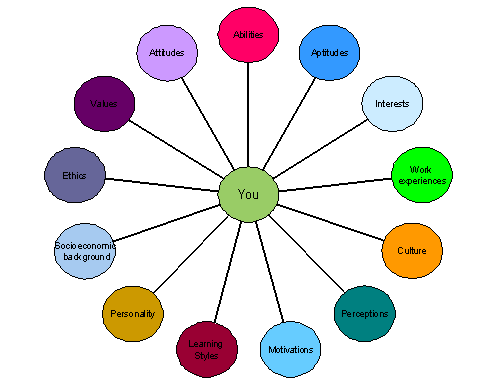| |
Diversity includes all of the differences that make us
unique. Workplace diversity is not just about Equal Employment
Opportunity (EEO) or Affirmative Action (AA); it's broader.
Diversity encompasses and acknowledges any difference amongst
individuals. What makes individuals so different or diverse?
Here are just a few areas:

In order to manage diversity effectively in the workplace
we need to include people, recognise them as individuals
and utilise what makes them different.
Why manage diversity?
There are many reasons why we should
manage diversity in our organisations and workplace, here
are just a few:
- Social justice
- Anti discrimination obligations
- Benefits on productivity and profitability
- Provides a competitive advantage in
the world market
- Positive impacts on organisational
behaviour and effectiveness
- Business case
- Ideological Reasons
- Supports a process of managing change,
particularly due to social and demographic changes in
the workplace
- Supports a corporate image as an “Employer
of Choice”
Diversity may be seen as a wide
ranging process of management. So how can we as individuals
encompass diversity into our daily work life and bring
this concept into our team? Here are just a few things
to consider:
- Be aware of EEO in the workplace and
actively integrate these principles in all areas such
as recruitment, training and development, performance
management, coaching, accessing leave, negotiating flexible
or alternate work practices etc.
- Be aware of the way that people interact
in your team and respond to each other. Does everyone
in your team treat people with respect and in a fair,
just and equal way?
- Acknowledge the differences in your
team member's cultural backgrounds. For example, try
to increase your understanding and knowledge of different
cultures, consider discussing differences in culture
during team meetings, invite team members to bring in
food from their culture for morning teas/lunches or try
different cultural restaurants for special occasions.
- Try to understand as much as you can
about the abilities, aptitudes, skills and interests
of your individual team members? Are you capitalising
on people's visible and hidden talents? Consider utilising
people's abilities, aptitudes, skills and interests in
different ways or when the need arises.
- If possible learn as much as you can
about the work experiences of your team members. Can
you utilise their backgrounds, knowledge or experiences
from other industries more effectively?
- Learn as much as you can about what
motivates you and others? Are you motivated by power,
affiliation or accomplishment? Motivation is our willingness
to exert effort to achieve a goal or perform a task.
We are all motivated by different things. Knowledge of
motivation can help us all to understand what makes people
enthusiastic to approach some tasks and procrastinate
with others.
- Try to learn and understand more about
the behaviour of those in your team. Do you understand
why people act or react the way that they do? Do you
know why people behave in a particular way when they
are under pressure or stress? Understanding behaviour
can help us to improve our relationships and interactions
with people on a daily basis. Understanding behaviour
may involve a series of team development activities combining
the use of behavioural tools and an experienced facilitator
to guide this process.
- Be conscious of the types of team
building activities that you undertake. Do they include
everyone or can allowances be made so that everyone can
participate? Do the activities allow people with disabilities,
different physical abilities or ages to participate?
Do team building activities take into consideration cultural
differences or values? E.g. food or alcohol inclusion
in activities.
- When organising team events, meetings,
offsite etc, do you take into consideration the personal
needs or dependent care responsibilities of different
team members?
- Do you know how your team members
like to learn? Do you understand their individual learning
style? An understanding of how others learn can help
us to change behaviour by detecting and correcting errors
and assist people to acquire new knowledge or skills.
Consider presenting or sharing information with team
members in different ways to enable people to understand
messages or information more effectively.
- Do the values, ethics and behaviour
of your team match those of your organisation? Or, do
your team or individual members operate differently?
- Is you team homogenous or heterogenous
? That is, is your team made up of people who are the
same or different? Diverse teams can operate and achieve
high performance outcomes, creative results and leading
edge solutions.
Noted in the book “Organisational Behaviour” by
Linda Chaousis, diversity gets people in the door and
inclusion keeps them there. Inclusion means finding ways
for people to connect in the workplace and be involved
on a daily basis. Diversity is a good thing for teams
and business. While for some, managing diversity may
be seen as a challenge, the key to making diverse teams
operate effectively is to find ways to include everyone,
to accept and tolerate differences and to actively capitalise
on the diversity of talents and perspectives that exist
in people.
References
Human Resource Management in Australia, Strategy, People,
Performance. Helen De Cieri and Robin Kramar. McGraw Hill
Australia, 2003
Organisational Behaviour- Concepts, Controversies and
Applications. Fifth Edition. Stephen P. Robbins. Prentice
Hall 1991
Organisational Behavior- Linda Chaousis. Prentice Hall,
2000.

|

